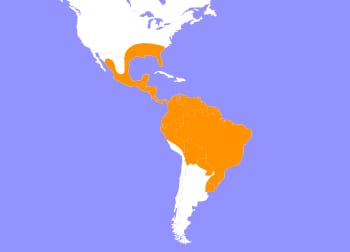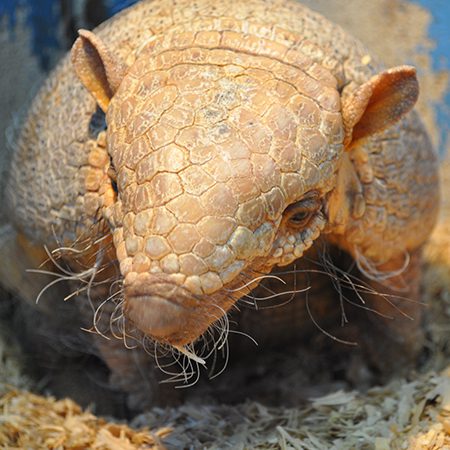Armadillo
Tolypeutes (3 Banded)
Armadillos are most recognizable for their specialized armor that cover their backsides, offering a tough shield against predators. This armor is composed of ossified dermal scutes (bone remodeling by laying new bone material on the skin tissue) which is covered by non overlapping keratinized scales, connected to flexible bands of skin. The underside and legs of an armadillo have no armored protection, rather it’s covered in long coarse hairs. The Tolypeutes genus of armadillo including the Brazilian and southern species of three-banded armadillos, has a unique ability to roll up tightly into an almost impenetrable ball. Armor of the three-banded armadillo is slightly more flexible than of its relatives, allowing for more freedom of movement. This more flexible armor also allows air to flow into the body between the skin and armor, helping it to stay cool and regulate its body temperature.
In addition to their scaly armor, armadillos have long front claws, which makes them efficient diggers. Armadillos use their claws to form burrows, and search for prey. They are omnivorous, feeding on insects, ants, carrion, and plant material. Armadillos have poor eyesight, and rely on their keen sense of smell to detect prey. Once they find a meal, they’ll use their long narrow tongues to lick up the food!
Say Hello To Cub Creek's Armadillo: Ben
Ben is our petite three banded armadillo. His species is the only kind that can completely curl into a complete ball! He is an active runner at night and is quite content showing off his special curling trick during the day!

All species of Armadillo are native to the Americas (North & South).
HABITAT -Armadillos live in the savannah regions of Central and South America.
DIET -They are omnivorous animals, eating ants, carrion, other insects, and plant material.
FUN FACT -The nine-banded armadillo is the official state small mammal of Texas.
SOCIAL BEHAVIOR -Generally live a solitary life, other than in mating season.
ACTIVITY -Armadillos are largely nocturnal, and come out to forage around dusk, are also known to be active during the day.
PREDATORS -Predators consist of coyotes, cougars, wolves, bears, raccoons, large birds of prey, and humans.
SIZE -Size varies, smaller three-banded are 9 - 11in long weighing, 2 - 3 lbs.
RELATIVES -There are 20 different known species of Armadillo. They are also related to sloths and anteaters.
CONSERVATION -Three-banded armadillo are considered vulnerable, while six-banded are of least concern.
Cub Creek Animal Care Information
Housing - We provide a dyad of enclosures for our two armadillos. Our three banded armadillo lives in the small animal room, in a large sized - open top petter. We bed his enclosure with small mounds of shavings, simulating an environment that he can use his claws to dig! He loves to rearrange his enclosure all the time! He has a large covered top hide that he sleeps in during the day. At night time he can be seen scurrying around and moving things around to his liking. Our six banded armadillo lives in a specialized multi species enclosure with a colony of ring-tailed lemurs. This enclosure is a large room that gives him plenty of room to run around, piled with small mounds of shavings.
Diet - They are fed a diet consisting of dry and wet food, and a mixture of fruits and vegetables (shredded sweet potato and diced / shredded apples). We also feed them invertebrates, and they love to eat eggs!
Enrichment - We love to let our six banded armadillo roam and explore around the hallway out, you can hear his claws clicking around as he runs up and down the hallway with joy. During the summer time, when campers adopt these animals for the week, they will make special toys for them to play with cardboard and other materials.


